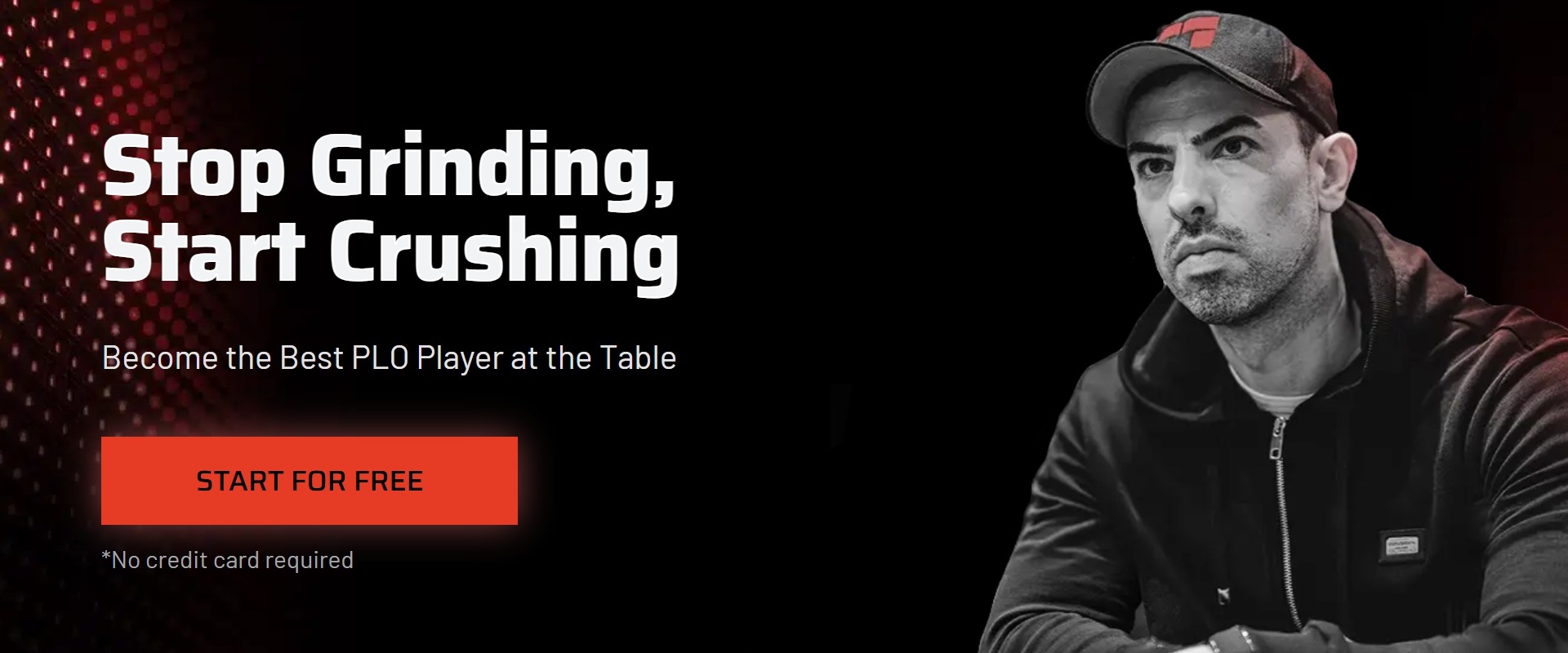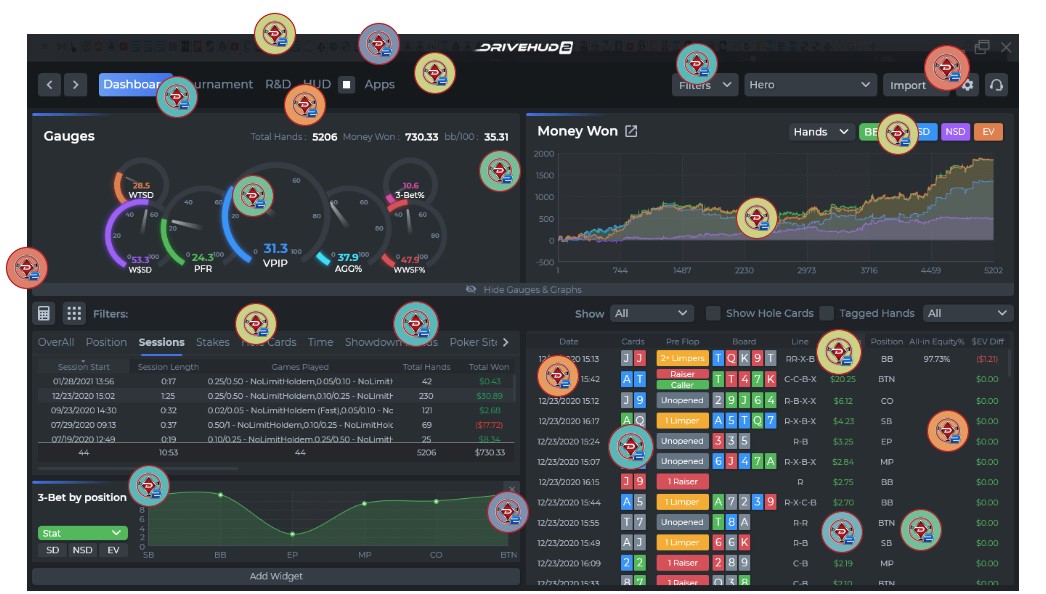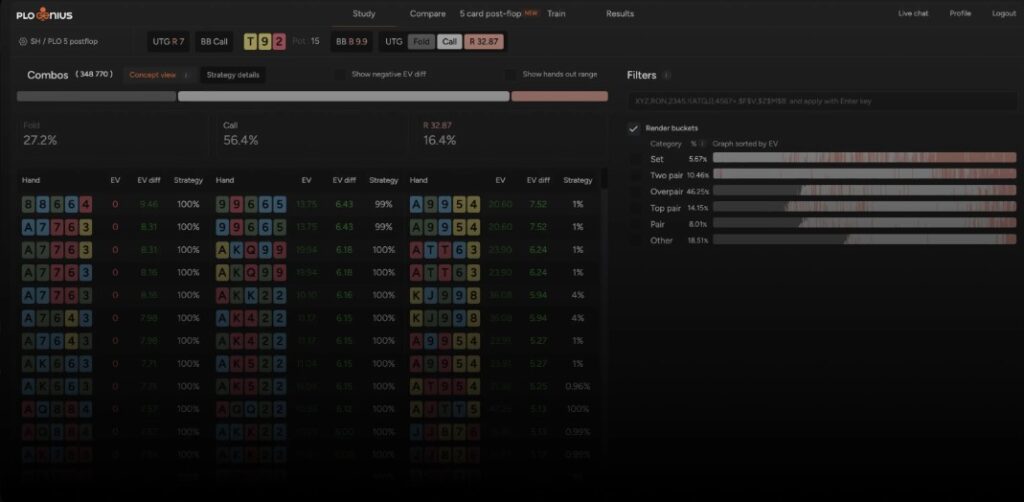What is Pot Limit Omaha
Pot Limit Omaha, also known as PLO, has emerged as one of the most thrilling and strategically complex variants in the poker world. As players seek to master Pot Limit Omaha strategy, they discover a game that offers deeper complexity and more action than traditional Texas Hold’em.
If you are interested in diving into the delicate nuances, you can learn the key differences between PLO and Texas Hold’em here.
This comprehensive guide explores the fundamentals of Pot Limit Omaha, helping both beginners and experienced players navigate the intricacies of this fascinating poker variant.
Best Pot Limit Omaha sites right now:
Juicy Stakes Poker
36% Rakeback
Spin & Gos with up to 12,000x your Buy-in
Network: Horizon Poker
Champion Poker
Network: iPoker
Quick Overview
- Understanding Pot Limit Omaha rules is crucial, as players must use exactly two of their four hole cards with three community cards
- Pot limit omaha betting follows specific structures, with maximum bets equal to the current pot size
- Mastering Pot Limit Omaha starting hands is essential for long-term success
- Table position significantly impacts preflop decision-making and overall strategy
- Postflop play requires careful board reading and draw assessment
- Bluffing opportunities are less frequent compared to other variants
- A proper bankroll strategy is vital due to increased variance
- Both online and live games require distinct tactical approaches
Understanding the Pot Limit Omaha Basics
Definition of Pot Limit Omaha
Pot Limit Omaha (PLO) is a dynamic poker variant that distinguishes itself by dealing players four hole cards instead of the traditional two found in Texas Hold’em.
What makes it unique is the requirement that players must use exactly two of their hole cards combined with three community cards to create their optimal five-card hand.
Historical Background
The evolution of the 4-card poker variant spans several decades, but its surge in popularity occurred during the mid-2000s, particularly in the online poker sphere. This growth was catalyzed by high-stakes players demonstrating advanced strategies for tournament play in televised events, which captured the attention of poker enthusiasts worldwide.
Popularity of Pot Limit Omaha in Modern Poker
In today’s poker landscape, the 4-card poker variant has established itself as the second most prevalent poker variant, trailing only Texas Hold’em. The game’s intricate strategic elements and potential for complex decision-making have made it a favorite among both recreational players and professionals.
Key Differences Between Pot Limit Omaha and Texas Hold’em
While sharing some fundamental similarities, several key distinctions set these games apart:
- Number of Hole Cards: Players in PLO receive four hole cards, contrasting with Hold’em’s two.
- Betting Structure: The betting structure restricts wagers to the current pot size.
- Hand Construction: Understanding the hand rankings is crucial, as players must use exactly two hole cards of their four hole cards, leading to unique hand strength dynamics.
Basic Rules
- Each player receives four hole cards at the start.
- Players combine two hole cards with three community cards for their best hand.
- Betting follows the same structure as Texas Hold’em: pre-flop, flop, turn, and river rounds.
Common Misconceptions About PLO
A frequent misconception among newcomers is treating the 4-card poker variant similarly to Texas Hold’em. However, the differences in hand construction and strategy create a distinct gaming experience requiring specialized knowledge and skills.
Find the best gaming experience here. The Crypto Poker SiteCoinPoker now also offers convenient deposit options, such as VISA, Mastercard and bank wire:
The Pot Limit Omaha betting structure
Explanation of Pot Limit Betting
In PLO poker, the ‘pot limit’ designation means players can bet up to the total pot size, unlike no-limit games where entire stacks can be wagered. This betting structure creates unique dynamics that players must master for successful gameplay.
Calculating Pot Size
The pot size calculation involves adding the current pot to any active bets. For instance, with a $100 pot and a $50 bet, the pot becomes $150. The next player can then bet up to $200.
Examples of Pot Limit Betting Preflop
- Small Blind: $5
- Big Blind: $10
- Maximum raise: (3x big blind) + small blind > (3×10) + 5 = $35
Differences Between Pot Limit and No Limit Betting
- Pot Limit: In pot limit omaha betting, players can wager up to the current size of the pot.
- No Limit: Players have the freedom to bet their entire stack at any time.
Impact of Pot Limit Betting on Game Strategy
The pot limit structure demands a more calculated approach to betting. Unlike no-limit games, players must carefully consider their strategy since they cannot simply push all their chips in. This restriction requires a deeper understanding of the rules and precise calculation of betting amounts.
Common Mistakes in Pot Limit Betting
- Pot Size Miscalculation: Many players struggle with accurate pot size calculations, leading to suboptimal betting decisions.
- Insufficient Betting: Making smaller bets than optimal can allow opponents to see additional cards cheaply, particularly detrimental in Pot Limit Omaha online play.
- Position Mismanagement: Not leveraging the position effectively can significantly impact the winrate.
Pot Limit Omaha Start Hands Selection
In the 4-card poker variant, selecting appropriate starting hands is vital for long-term success. Unlike Hold’em, where players can often succeed with marginal holdings, PLO requires stronger starting hands due to the four-card nature of the game.
Best Starting Hands
When learning how to play Pot Limit Omaha, focus on hands offering both power and versatility. Premium starting hands include:
- A♠A♦K♠K♦ (Double-suited)
- A♠A♦J♠10♦ (Double-suited)
- J♠10♦9♠8♦ (Connected)
These combinations provide strong potential for winning the pot through high pairs and/or drawing possibilities.
Double-Suited Hands and Their Advantages
Double-suited holdings are particularly powerful. They offer two distinct flush possibilities, significantly increasing the potential to make strong hands. A hand like A♠A♦7♠6♦ exemplifies this concept.
Connected Hands and Their Importance
Connected hands, such as J♠10♦9♠8♦, are an essential part of your starting hands, and often even better than some Double Ace combinations. The connectivity between cards creates numerous straight and flush possibilities.
Common Starting Hand Mistakes
Players often make these errors when selecting starting hands:
- Playing too many speculative hands
- Overvaluing single-pair hands
- Ignoring positional considerations
If you don’t want to make these costly mistakes, we highly recommend signing up for PLOMastermind, the best Pot Limit Omaha training site.

Adjusting Starting Hand Strategy Based on Position
Position plays a crucial role in determining our starting hand selection. In early positions, we should maintain a tighter range, focusing primarily on premium holdings that can withstand aggression. When playing Pot Limit Omaha online, late position allows us greater flexibility to incorporate a broader spectrum of playable hands.
To achieve consistent success in pot limit omaha poker, mastering starting hand selection is essential. By prioritizing strong, coordinated, and double-suited combinations while considering positional advantages, we significantly enhance our winning potential.
Preflop Strategy
Understanding Preflop Equity
Mastering PLO requires a deep understanding of preflop equity. Unlike traditional Hold’em games, Pot Limit Omaha hand rankings are more nuanced, with starting hands often having closer equity margins. This characteristic necessitates more selective and strategic hand choices.
Importance of Position in Preflop Play
Position significantly influences our preflop decision-making in Pot Limit Omaha online play. Later positions provide valuable information about opponents’ actions, helping implement effective strategies. Consider these key aspects:
- Employ premium hands from early position.
- Expand hand selection in late position.
- Adapt based on opponent tendencies.
The PLO training website PLOMastermind offers free preflop training.
Raising and Calling Preflop
When considering pot limit omaha betting decisions preflop, hand strength and position should guide our choices. Follow these fundamental guidelines:
- Raise with premium holdings.
- Call with speculative hands when positioned advantageously.
- Avoid calling substantial raises with marginal hands.
Common Preflop Mistakes
Many players learning how to play PLO make costly preflop errors. Watch for these common mistakes:
- Excessive hand selection.
- Overestimating marginal holdings.
- Disregarding positional importance.
Adjusting Preflop Strategy Based on Opponents
Adapting our strategy according to opponent tendencies is crucial for mastering pot limit omaha. Against tight players, we can broaden our range, while against loose opponents, implementing tighter advanced Pot Limit Omaha strategies for tournament play becomes essential.
Examples of Effective Preflop Play
Consider these scenarios demonstrating effective preflop decisions:
- Early position: Raise with A♠A♦K♠J♦.
- Late position: Call with J♠10♠9♦8♦.
- Versus tight opponents: Fold weaker holdings like 4♣5♣3♦2♦.
In pot limit omaha, preflop decisions lay the groundwork for postflop success. Strategic hand selection and positional awareness significantly improve our winning potential.
Postflop Strategy in PLO
Reading the Board
Understanding board texture is vital in Pot Limit Omaha. Analyzing community card interactions with our holdings and potential opponent hands is crucial. Strong board textures can dramatically alter hand dynamics.
Importance of Draws in Postflop Play
Draws are fundamental to effective pot limit omaha strategy. Understanding and properly evaluating drawing hands significantly impacts our postflop success. Consider these essential guidelines when playing Pot Limit Omaha:
- Prioritize drawing to the nuts to maximize potential returns.
- Carefully assess both straight and flush draw possibilities.
- Monitor board texture’s impact on opponent ranges.
Betting and Raising Postflop
In pot limit omaha poker, postflop betting decisions require careful strategic consideration. Our actions should reflect both hand strength and board dynamics. Consider these pot limit omaha betting principles:
- Value betting with strong made hands and premium draws.
- Bluffing selectively when board texture favors our range.
- Raising to protect strong drawing hands and build pot equity.
Common Postflop Mistakes
When implementing pot limit omaha strategy, players often encounter these common pitfalls:
- Overvaluing non-nut holdings in multiway pots.
- Misreading board texture implications.
- Failing to adapt strategy based on opponent tendencies.
Adjusting Postflop Strategy Based on Board Texture
Board texture significantly influences our Pot Limit Omaha strategy. Consider these adjustments:
- Modify play style according to wet (draw-heavy) versus dry boards.
- Factor in opponent numbers and their likely holding ranges.
Examples of Effective Postflop Play
To illustrate effective pot limit omaha online play, consider these scenarios:
- With strong drawing hands on coordinated boards, aggressive betting builds pot value.
- On disconnected boards, focus on value betting made hands while maintaining pot control.
Advanced Strategies in Pot Limit Omaha
Bluffing
When mastering PLO, understand that bluffing requires careful consideration. While bluffing remains viable, it’s generally less effective than in other variants. Focus on building strong hands rather than relying heavily on bluffs.
Semi-Bluffing and Its Effectiveness
Semi-bluffing represents a robust strategy when holding drawing hands. This approach enables pressure application while maintaining the potential for hand improvement.
Slow Playing Strong Hands
When holding premium hands, consider slow playing to maximize value sometimes. While effective, this advanced strategy requires careful implementation to avoid missing value or falling behind against your opponent on later streets.
Exploiting Opponents’ Weaknesses
Understanding opponent tendencies is crucial for winning. Identify and exploit behavioral patterns, such as frequent folding to aggression. We can highly recommend the Poker Tracking Tool DriveHUD2, which is by far the best on the market.

Balancing Your Range
Maintaining unpredictability requires a balanced approach. Mix strong holdings with strategic bluffs to prevent exploitation. If you are a beginner, we suggest skipping this topic for now and focusing on the key essentials.
Advanced Hand Reading Techniques
Mastering hand reading skills is crucial to succeed in PLO. Players should consistently practice identifying potential holdings in their opponents’ ranges based on betting patterns and actions. This fundamental skill dramatically improves decision-making capabilities at the tables.
In Pot Limit Omaha, the game’s inherent complexity demands continuous strategy adaptation. By mastering these advanced techniques, players can significantly enhance their overall win rate.
Common Mistakes in PLOa
Overvaluing Hands
When learning how to play PLO, players frequently overestimate their hand strength. Unlike Hold’em where single pairs can win, the 4-card poker variant typically requires much stronger holdings. Remember that even premium starting hands like aces can be vulnerable postflop.
Playing Too Many Hands
A common pitfall is playing excessive starting hands. Successful players maintain strict hand selection criteria, focusing on premium holdings and resisting the temptation to play marginal hands. Successful players usually play around 30% of their starting hands.
Ignoring Position
Position plays a critical role in PLO. Many players undervalue their table position, leading to suboptimal decisions. Always consider your position relative to the button when planning your strategy.
Failing to Read the Board
Accurate board reading is essential for mastering Pot Limit Omaha. Players often overlook potential combinations available with community cards. Careful board analysis and range assessment are crucial skills for success.
Underestimating Opponents
Underestimating opponents can be costly. Stay vigilant of betting patterns and tendencies. Understanding opponent gameplay provides significant strategic advantages.
Not Managing Bankroll Effectively
Implementing proper Pot Limit Omaha bankroll management strategies is vital. Many players fail to establish appropriate limits, resulting in substantial losses. Setting and adhering to strict bankroll guidelines ensures long-term sustainability.
PLO Cash Games
Differences Between Cash Games and Tournaments
Advanced Pot Limit Omaha strategies for tournament play differ significantly from cash games. Cash games allow flexible buy-ins and continuous play, while tournaments require fixed entry fees for prize pool participation. This fundamental distinction influences strategic approaches in each format.
Adjusting Strategy for Cash Games
When playing cash games, consider these factors:
- Implement strict bankroll management to handle variance effectively
- Utilize a broader starting hand range due to rebuy availability
- Focus on exploiting recreational players’ tendencies
Importance of Bankroll Management in Cash Games
Effective bankroll management remains crucial in cash games. Here are essential considerations:
- Establish strict bankroll limits for each session to manage potential losses effectively.
- Select stakes that align with your bankroll size to ensure sustainable gameplay.
- Monitor and adjust your bankroll strategy based on performance metrics and results.
Common Cash Game Mistakes
When playing Pot Limit Omaha online, players often make several critical errors. Key mistakes to avoid include:
- Overestimating hand strength, particularly in PLO where four-card combinations create complex dynamics.
- Entering too many pots without considering positional advantage.
- Failing to observe and adapt to opponents’ playing patterns and tendencies.
Examples of Effective Cash Game Play
To demonstrate successful strategy implementation, consider these scenarios:
- Position Utilization: Leveraging late position allows for aggressive play with a wider range of starting hands, creating profitable opportunities.
- Opponent Adaptation: When identifying overly aggressive players, tighten your starting hands and capitalize on their mistakes with premium holdings.
- Emotional Control: Maintaining composure during downswings enables better decision-making and adherence to bankroll management strategies.
Success in pot limit omaha cash games requires understanding game dynamics and implementing appropriate strategic adjustments based on table conditions.
PLO Tournaments
Differences Between Tournaments and Cash Games
Tournament play presents unique challenges compared to cash games. Understanding these distinctions is essential for masteringthe 4-card poker variant. Consider these fundamental differences:
- Blind Structure: Escalating blinds influence betting decisions and timing.
- Elimination Format: The risk of tournament elimination affects strategic choices.
- Chip Considerations: Tournament chips represent tournament equity rather than direct monetary value.
Adjusting Strategy for Tournaments
To excel in tournaments, implement these strategic adjustments:
- Conservative Hand Selection: Prioritize premium hands during early stages.
- Late-Stage Aggression: Increase aggression as blinds rise to accumulate chips.
- ICM Awareness: Factor Independent Chip Model considerations into decisions.
Importance of Chip Management in Tournaments
Effective chip management is crucial for tournament success. Players should:
- Minimize Early Risks: Preserve your chip stack for later stages when blinds increase.
- Read Opponents: Adapt strategy based on opponents’ playing styles.
- Timing All-ins: Identify optimal moments for all-in moves with strong holdings.
Common Tournament Mistakes
Even experienced players make these tournament errors:
- Hand Overvaluation: Remember that strong hands don’t guarantee victory.
- Position Negligence: Always consider table position in decision-making.
- Strategic Inflexibility: Adjust tactics based on tournament stage and opposition.
Examples of Effective Tournament Play
To illustrate winning tournament strategies, consider these scenarios:
- Early Stage: The initial phase demands conservative play with a focus on premium starting hands. This approach helps establish a solid foundation while minimizing unnecessary risks.
- Middle Stage: As the tournament progresses, we can begin expanding our range and applying strategic pressure. Understanding Pot Limit Omaha betting patterns becomes crucial during this phase.
- Final Table: The culmination requires aggressive play and the ability to exploit weaker opponents. Advanced Pot Limit Omaha strategies for tournament play become essential at this stage.
Success in pot limit omaha tournaments hinges on our ability to adapt strategies and manage chips effectively. Unterstanding and mastering the table dynamics is crucial for any player aiming to achieve consistent results.
Training and Improving Your PLO Skills
Importance of Continuous Learning
In the dynamic world of PLO, continuous learning forms the cornerstone of success. As the game evolves, we must consistently update our understanding of new strategies and adapt to emerging gameplay trends.
Top Training Sites for Pot Limit Omaha
There are a few training sites out there, but we highly recommend the Pot Limit Omaha training site PLOMastermind. It offers the best learning videos, courses, strategy articles and coaches for beginners and ambitious players who want to become professionals.

Using Software Tools to Enhance Skills
Leveraging technology enhances skill development. Modern tools like tracking software and pot limit omaha calculators enable detailed analysis and informed decision-making.
We highly suggest the Poker Tracking Tool DriveHud2. It offers a dynamic Heads-up Display during your online oker session and tracks your and your opponents performance in your own private database.

Psychological Aspects of Pot Limit Omaha
Importance of Mental Toughness
The right Poker Mindset plays a crucial role in success. Players frequently encounter significant bankroll fluctuations, making psychological resilience essential for maintaining focus and making optimal decisions during challenging sessions.
Dealing with Variance
Variance represents an inherent aspect in the game. Understanding and accepting that losses can occur despite sound play helps maintain perspective and avoid emotional decision-making during downswings. Check out this article about How to handle variance like a pro.
Managing Tilt
Emotional control significantly impacts performance. To effectively manage tilt, consider:
- Taking strategic breaks during challenging sessions
- Implementing mindfulness techniques
- Conducting objective analysis of gameplay decisions
Master mindfulness for peak performance to ace your poker sessions every day.
Staying Focused During Long Sessions
When playing Pot Limit Omaha online, extended sessions can lead to mental fatigue, significantly impacting our decision-making abilities. To maintain optimal performance during lengthy sessions, we should implement these essential practices:
- Establish strict time boundaries for our gameplay sessions.
- Schedule regular intervals for mental refreshment and physical movement.
- Maintain proper hydration and nutrition throughout the session.
Reading Opponents’ Psychological States
Understanding our opponents’ mental states provides a significant competitive advantage. By carefully observing betting patterns and analyzing physical tells during live games, we can better gauge their confidence levels and emotional states, allowing for more informed decision-making.
Using Psychology to Your Advantage
Mastering the 4-card game requires skillful application of psychological tactics to influence opponents’ decisions. Key strategies include:
- Executing well-timed bluffs to create uncertainty
- Implementing dynamic play styles to maintain unpredictability
- Developing an intimidating table presence to exploit less experienced players
Bankroll Management in Pot Limit Omaha
Importance of Bankroll Management
When learning how to play PLO, implementing effective bankroll management strategies becomes crucial for sustained success. Proper management prevents bankruptcy and enables comfortable play without financial pressure affecting our decisions.
You can be the best Pot Limit Omaha player in the world. But without proper bankroll management, you can lose your whole bankroll in a single day.
Setting Bankroll Limits
To effectively manage our bankroll, we should:
- Establish a concrete bankroll allocation.
- Implement session-specific loss limits
- Modify limits based on current skill level and stake selection
Adjusting Bankroll Based on Game Type
Different formats, including 5-card and 6-card require distinct bankroll approaches:
- Cash Games: Maintain a minimum of 50 buy-ins for chosen stakes
- Tournaments: Reserve 50-100 buy-ins to account for increased variance
Common Bankroll Management Mistakes
Players often commit these detrimental bankroll errors:
- Participating in games beyond their bankroll capacity
- Increasing stakes to recover losses
- Neglecting proper bankroll distribution
Understanding rakeback opportunities and implementing sound bankroll management principles ensures long-term sustainability and continued skill development. Find the best Poker rakeback deals here.
Online vs. Live
Differences Between Online and Live Play
When comparing online and live, several key factors influence gameplay dynamics. Online platforms offer accelerated play and convenience, while live venues provide valuable social interaction. Notable distinctions include:
- Game Speed: Online PLO progresses significantly faster than live games
- Betting Process: Online platforms streamline betting with automated calculations, whereas live games require manual betting procedures
- Player Interaction: Live environments enable direct opponent observation, while online play relies on betting patterns and timing tells
Adjusting Strategy for Online Play
When playing Pot Limit Omaha online, we must adapt our strategies to account for the unique characteristics of the digital format. Here are key strategic considerations:
- Leverage Software Tools: Advanced calculators and tracking software can provide valuable insights for analyzing gameplay patterns and refining strategies. Please always read the poker site’s terms and conditions to learn what is allowed.
- Embrace Rapid Decision-Making: Online games move at a faster pace, requiring quick yet calculated decisions without compromising strategic depth.
- Exercise Strategic Patience: Despite the accelerated tempo, maintaining discipline with starting hands selection remains crucial for long-term success.
Adapting Strategy for Live Environment
When transitioning to live poker, players should modify their approach accordingly:
- Study Physical Tells: Capitalize on the ability to observe opponents’ behavioral patterns and physical reactions during hands.
- Foster Table Dynamics: Developing connections with fellow players can yield valuable strategic insights and playing tendencies.
- Optimize Time Usage: Live games progress more slowly, allowing for deeper analysis of Pot Limit Omaha hand rankings and strategic decisions.
Benefits of Digital Play
Playing online offers distinct advantages that enhance the gaming experience:
- Convenient Access: Enjoy the game of Pot Limit Omaha from any location at your preferred time, fitting seamlessly into busy schedules.
- Diverse Game Selection: Online platforms feature extensive stakes ranges and tournament formats for all skill levels.
- Rewarding Incentives: Take advantage of the best rakeback deals and promotional offers to maximize value.
Find the best PLO sites here:
Juicy Stakes Poker
36% Rakeback
Spin & Gos with up to 12,000x your Buy-in
Network: Horizon Poker
Champion Poker
Network: iPoker
Live Gaming Advantages
Conversely, live poker provides unique benefits:
- Rich Social Experience: Enjoy meaningful interactions and build relationships within the poker community.
- Enhanced Concentration: Minimize digital distractions for improved focus on advanced strategies for tournament play.
- Authentic Experience: Physical chips and cards create an immersive gaming atmosphere that many players prefer.
Universal Pitfalls to Avoid
Regardless of format, be mindful of these common mistakes:
- Hand Strength Misconceptions: Players frequently overestimate their holdings in both online and live formats.
- Positional Awareness: Failing to leverage table position effectively can lead to suboptimal decisions.
- Poor Bankroll Strategy: Whether playing online or live, implementing sound Pot Limit Omaha bankroll management strategies is essential for sustainability.
Popular Pot Limit Omaha Variants
4-Card PLO
PLO features four hole cards per player. This foundational variant serves as the entry point for most players adventuring away from Texas Hold’em. Players must utilize exactly two hole cards combined with three community cards to create their strongest hand.
5-Card PLO
This expanded variant deals five hole cards to each player. Though less prevalent, it creates additional hand possibilities while maintaining the two-card requirement for final hand construction.
Six-Card PLO
Similar to five-card, this variant provides players with six hole cards, significantly increasing the complexity and potential for creating powerful hands. Players must still follow the fundamental rules of using exactly two hole cards in combination with the community cards to form their final hand.
Responsible Gambling Practices
Practicing responsible gambling is vital for a healthy gaming experience. We recommend the following:
- Set limits: Establish a budget for your gaming sessions.
- Take breaks: Regularly step away from the table to maintain focus.
- Seek support: If gambling becomes a problem, reach out for help.
Growing Popularity of Pot Limit Omaha
The interest in PLO is on the rise. This can be attributed to:
- Many NLHE players are considering transitioning to PLO, as GTO has solved No Limit Hold’em almost entirely.
- Another reason is that NLHE players are afraid of bots online. Playing against bots on Pot Limit Omaha tables is far less likely.
- Pot Limit Omaha is more fun than No Limit Hold’em.
- High-Stakes Games: The visibility of high-stakes PLO games and tournaments has attracted attention.
- Community Engagement: Online forums and communities are fostering discussions and sharing strategies.
- Celebrity Players: Well-known poker players endorsing PLO are drawing in fans.
Pot Limit Omaha is pure Entertainment
There are numerous PLO live streams and videos available online, for example, from Hustler Casino Live or the Triton Series.
Ben Lamb, Nik Airball, Huss and others playing $500/1K/2K PLO at the Hustler Casino live:
Watch how Tom Dwan dominates the Super High Stakes PLO streets:
And this video is a bit older but shows one of the most epic Pot Limit Omaha hands to date:
Future of Online Pot Limit Omaha
The online landscape for PLO is evolving rapidly. We anticipate:
- More Competitive Environments: Increased competition among online sites to attract players. Which means better bonuses and rakeback deals.
- Innovative Game Formats: New game formats that cater to different player styles.
- Mobile Accessibility: Enhanced mobile platforms for playing PLO on the go.
- As more NLHE players transition to PLO, we believe the next years will be a little gold rush for established Pot Limit Omaha players.
Predictions from Experts
Experts predict that PLO will continue to grow in popularity. They suggest:
- Increased Player Base: A steady influx of new players will keep the game vibrant.
- Greater Acceptance in Tournaments: More tournaments featuring PLO will emerge.
Resources for Pot Limit Omaha Players
Best Pot Limit Omaha training site
PLOMastermind is the best training site for beginners and ambitious players, who aim to become professionals.

Software Tools for Pot Limit Omaha
DriveHUD2: The Ultimate Poker Tracking Tool
DriveHUD2 is a powerful poker tracking and HUD tool that can really enhance your game. It provides you with real-time statistics, customizable HUDs, and detailed hand histories to help you analyze your performance and make better decisions at the tables.

Jurojin Poker: Become a Masstabling Champion
Jurojin Poker is an advanced poker multitabling tool designed to make your life easier when playing multiple tables simultaneously. It gives you full control over your layout, letting you customize table arrangements and hotkeys so that you can focus on the game instead of juggling windows.
Whether you’re grinding tournaments or cash games, Jurojin helps you stay organized and efficient. You’ll love how smooth it makes multitabling, especially with features like automated table placement, focus mode, and intuitive controls.

PLOGenius: Perfect your Play
PLOGenius is a solver specifically built for Pot Limit Omaha, and it’s perfect if you want to dive deep into the strategic side of the game. It’s designed to help you analyze spots, study optimal plays, and really understand the math behind your decisions.
With PLOGenius, you can simulate scenarios and explore how different board textures, stack sizes, and bet sizes affect optimal strategies. If you’re serious about improving your PLO game, this tool is a no-brainer—it gives you the insights you need to crush your opponents and stay ahead of the curve.

Conclusion
In summary, Pot Limit Omaha is a super fun poker variant that offers unique challenges and opportunities for players. With its distinct rules and strategies, PLO requires a solid understanding of hand strength and pot odds. Players must adapt their approach, focusing on strong starting hands and being mindful of the betting structure.
As you explore this exciting game, remember that practice and patience are key to mastering PLO. Whether you’re a beginner or an experienced player, the journey in Pot Limit Omaha can be both rewarding and thrilling.
Ready to jump into the action?
Juicy Stakes Poker
36% Rakeback
Spin & Gos with up to 12,000x your Buy-in
Network: Horizon Poker
Champion Poker
Network: iPoker
Frequently Asked Questions
Pot Limit Omaha (PLO) is a type of poker game where players are dealt four cards instead of two. Players must use exactly two of their cards along with three community cards to make the best five-card hand.
In Pot Limit Omaha, players get four cards and must use two of them. In Texas Hold’em, players receive two cards. The betting structure also differs; PLO is pot-limit, meaning you can only bet up to the size of the pot.
Players start by receiving four hole cards. After a round of betting, three community cards are dealt, followed by more betting. Then, a fourth card is revealed, followed by another round of betting, and finally, a fifth community card is shown with a last round of betting.
Common mistakes include playing too many hands, overvaluing weak hands, and not paying attention to position. It’s important to be selective with starting hands and to read the board correctly.
Good starting hands usually include strong pairs and connected cards. Players should avoid hands with ‘danglers,’ which are cards that don’t connect well with the others.
To get better, focus on understanding pot odds, be patient with your hand selection, and learn to read the board and your opponents. Continuous learning and practice are key.
While PLO can be complex, beginners can still learn the game. It’s important to start with basic strategies and gradually improve as you gain experience.




